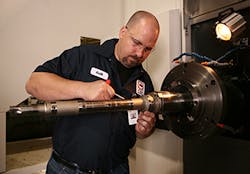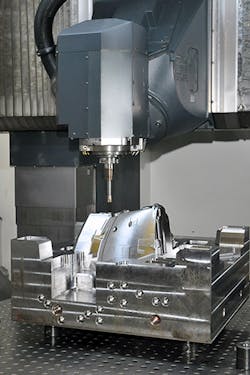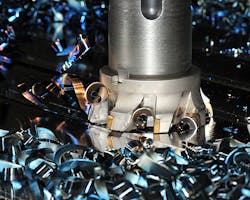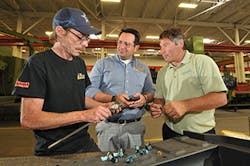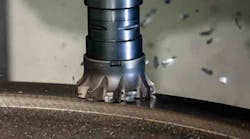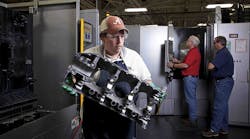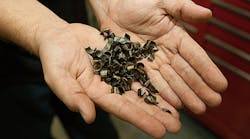Many specialty machine shops, regardless of their experience or expertise, nevertheless subscribe to various ‘accepted standards’ that may not be, or may no longer be true. They may be myths. Experience at three alert Canadian mold shops may dispel some myths that sometimes limit the machining productivity of shops in the U.S., or anywhere. To be specific:
Myth No. 1: In cavity milling, you must slow down for corners and long reaches.
Myth No. 2: It’s better to populate a new machine with familiar tooling. (Don’t put a new rider on a new horse.)
Myth No. 3: Larger ‘standard’ facemills must be special-ordered, and are limited to flat work.
Let’s unravel these fallacies one at a time:
No choice but to slow down?
Water may flow more slowly in the deep parts of a river, but you don’t necessarily need to slow the cutting rate in deeper die cavities. When Redoe Mold Inc. in Windsor, Ont., added an extra rigid boring mill to build deep-cavity injection molds in hardened P20 and H13, engineers assumed they’d still have to reduce cutting rates down near the bottom of the deepest parts of the design.
With the tooling and extension they were accustomed to using, the fastest they could feed at the bottom of an 18-in. cavity in the hardened mold stock was 50 IPM, and still they
were plagued with chatter and ruptured inserts. They had to limit deep-hole drilling penetration rates to 5 IPM for the same reasons.
With the switch to Ingersoll’s Inno-Fit extra rigid shank extension, Redoe now feeds at full speed all the way to the very bottom of the design. Feed rates for milling are five times faster, with twice the edge life and no sudden rupture. Penetration rates for 8:1-aspect holes have tripled to 12-18 IPM. “We’re milling at the bottom about as fast as we do on the surface with a stubby tool,” said lead machinist Jay Noble.
The keys to the Inno-Fit’s rigidity at extreme depths are a self-centering three-point coupling design, large surface contact area, and extremely wear-resistant material. Most other extension shanks use a slide coupling system, have no self-centering capability and use softer metals.
Also contributing to these rates are free-cutting tools that resolve cutting forces more axially than laterally. Rough milling is done with the new Hi-Feed Mini at 400 IPM and 0.030 in. depth of cut (DOC). Ingersoll Form-Master V facemills do the finishing passes at the same feed rate with lower DOC. Drilling, on deep holes up to 2-in. diam., is done with Ingersoll Quik-Twist indexable drills on Inno-Fit shanks.
According to Ingersoll’s Canadian field rep Paul Poirier, “With rigid shanks and sturdy high-feed tools that resolve cutting forces axially, deep cavities and high-aspect holes can be completed at surprising rates.”
Reko Manufacturing Group, also in Windsor, can tell you that there’s no need to slow down in corners either. On their new five-axis CNC mill, the company doubled throughput in cavity milling with an Ingersoll Hi-Feed Mini facemill. The retooling, from a button cutter billed as ‘high feed,’ also improved process security to the point that operations that once needed 100% attendance now run unattended.
“Tooling deficits in ‘high feed’ button cutters that may not be apparent in three-axis processing become painfully obvious in high-feed five-axis work -- especially in corners,” said Tom Hunt, manufacturing supervisor. “Previously, we always had to slow down in corners to avoid tool rupture, spindle overloading, or chip jamming. Not anymore.”
With the previous ‘high feed’ button cutter running at 600 SFM and 0.020-in. step-overs, the fastest safe feed rate was 100 IPM in the straightaways and far less in the corners. With the Hi-Feed Mini, the standard rate is 900 IPM through the corners as well as on the straightaways.
The Hi-Feed Mini corners faster because of its unusual insert geometry: The insert looks like a rectangle with radiused ends. “This enables a smaller cutter to cut fast in the straightaways and go deeper into a corner than a larger tool can,” explained Ingersoll’s Paul Poirier.
New Machine, New Tools?
Also of note: Reko Manufacturing made the tooling upgrade on their new five-axis CNC machine almost immediately. Throughput improved using their familiar ‘high feed’ button cutters, but it was nowhere near the machine’s limits and not without 100% operator attention. “We realized that the tooling that worked great on a three-axis machine was holding back the five-axis unit back,” said Hunt. “Nobody should allow tooling limitations to hold back a good machine. We retooled within two weeks and started reaping the benefits that same day.”
Do bigger mills limit your options?
Manufacturers that handle a steady diet of large-scale ramping work but avoid large milling cutters might take a page from Nova Tool and Mold Inc. in Windsor. The company, basically an Ingersoll shop, has a 75-HP vertical mill with the heft to make good use of a 6-in. cutter, but standardized on 2- and 4-in. Gold-Quad facemills running at 120 IPM with 75% step-over. Hearsay about contouring limitations on larger high-feed facemills caused Nova engineers to stick with the sizes they were using.
“In a mold shop with heavy cavity milling, we can’t justify spending $1,000 for a facemill body limited to flat work,” said John Novosel, Jr., president. Adding to his concerns was industry scuttlebutt that many large cutters are ‘standards’ in name only, and aren’t really stocked. To Novosel’s mind, he could be buying in to long delivery times for replacements and other supply-chain uncertainties.
It was an order for one huge automotive mold that started Novo engineer John Barsotta thinking about moving up to the six-inch facemill. The mold block weighed 17.5 tons and had an active area measuring 2x3x6 feet. Roughing alone would generate six tons of chips; the deepest cavities would require hogging out on 14-in. extensions. “If it worked, we’d save sixteen hours of heavy roughing alone,” said Barsotta, who is the plant manager.
To be certain, Barsotta reviewed the big tool’s track record on contouring with Bill Fiorenza, Ingersoll product manager for die and mold tools. They also checked the supply chain to verify that the tool was actually stocked and available for 24-hour delivery.
On the first trial cut, in a cavity eight inches deep, the 6-in. Gold-Quad F facemill ran smoothly at 100 IPM, 350 RPM, 0.100 in. DOC, with 5-in. step-overs. Chips the size of your thumb came off at 50 cu in./min, yet the operation ran smoothly and chatter-free. Later in the milling process, the results were the same on 14-in. extension.
Since that first job, Nova Tool has increased the feed rate to 120 IPM and 5 3/8-in. step-overs for those long reaches, which raised the MRR to 64 cu in./min. They also standardized on the 6-in. Gold-Quad facemill for the first roughing step on all incoming mold blocks. Fiorenza stated that the job’s removal rates are among the highest he’s seen under these conditions.
“Our only problem was we had to buy bigger chip bins just to keep up,” said Novosel. “That’s a problem we can live with.”
Introduced less than two years ago, the Ingersoll Gold-Quad family of facemills has become the “go-to” solution for a variety of high-feed facing and profiling, even with interrupted cuts. The extra-thick inserts handle both high feeds and deeper cuts as their free-cutting geometries reduce cutting forces. The combination enhances stability and reduces chatter in long-reach applications. A strong, oversized clamping screw ensures secure seating under extreme cutting forces. Finally, a proprietary post-coating technology smooths the surface and strengthens the bonds between coating and substrate to improve performance 35% on average.

